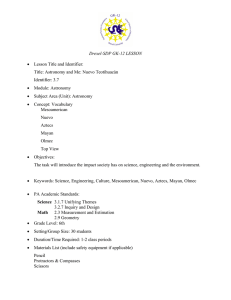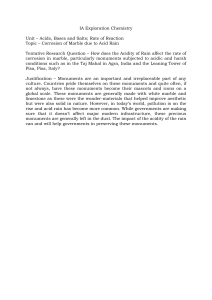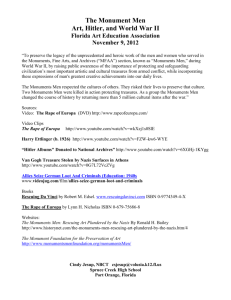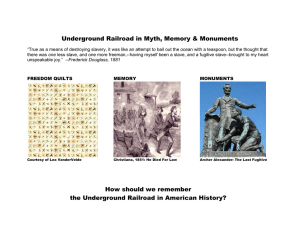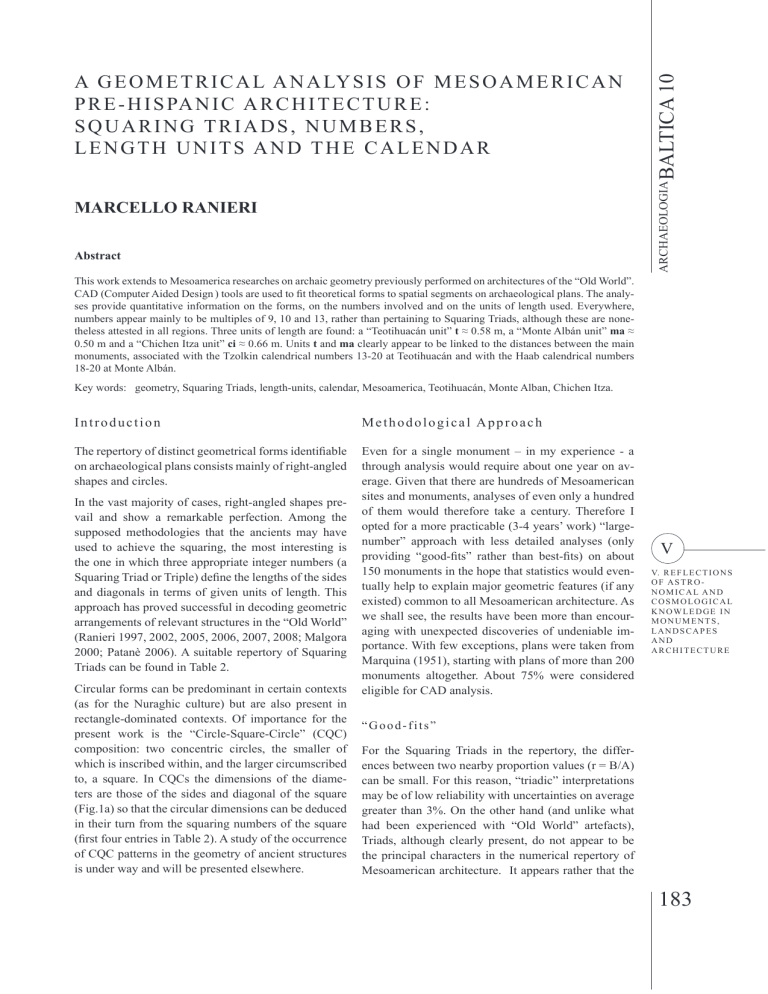
BALTICA 10 ARCHAEOLOGIA A G E O M E T R I C A L A N A LY S I S O F M E S O A M E R I C A N P R E - H I S PA N I C A R C H I T E C T U R E : SQUARING TRIADS, NUMBERS, LENGTH UNITS AND THE CALENDAR MARCELLO RANIERI Abstract This work extends to Mesoamerica researches on archaic geometry previously performed on architectures of the “Old World”. CAD (Computer Aided Design ) tools are used to ¿t theoretical forms to spatial segments on archaeological plans. The analyses provide quantitative information on the forms, on the numbers involved and on the units of length used. Everywhere, numbers appear mainly to be multiples of 9, 10 and 13, rather than pertaining to Squaring Triads, although these are nonetheless attested in all regions. Three units of length are found: a “Teotihuacán unit” t ≈ 0.58 m, a “Monte Albán unit” ma ≈ 0.50 m and a “Chichen Itza unit” ci ≈ 0.66 m. Units t and ma clearly appear to be linked to the distances between the main monuments, associated with the Tzolkin calendrical numbers 13-20 at Teotihuacán and with the Haab calendrical numbers 18-20 at Monte Albán. Key words: geometry, Squaring Triads, length-units, calendar, Mesoamerica, Teotihuacán, Monte Alban, Chichen Itza. Introduction Methodological Approach The repertory of distinct geometrical forms identi¿able on archaeological plans consists mainly of right-angled shapes and circles. Even for a single monument – in my experience - a through analysis would require about one year on average. Given that there are hundreds of Mesoamerican sites and monuments, analyses of even only a hundred of them would therefore take a century. Therefore I opted for a more practicable (3-4 years’ work) “largenumber” approach with less detailed analyses (only providing “good-¿ts” rather than best-¿ts) on about 150 monuments in the hope that statistics would eventually help to explain major geometric features (if any existed) common to all Mesoamerican architecture. As we shall see, the results have been more than encouraging with unexpected discoveries of undeniable importance. With few exceptions, plans were taken from Marquina (1951), starting with plans of more than 200 monuments altogether. About 75% were considered eligible for CAD analysis. In the vast majority of cases, right-angled shapes prevail and show a remarkable perfection. Among the supposed methodologies that the ancients may have used to achieve the squaring, the most interesting is the one in which three appropriate integer numbers (a Squaring Triad or Triple) de¿ne the lengths of the sides and diagonals in terms of given units of length. This approach has proved successful in decoding geometric arrangements of relevant structures in the “Old World” (Ranieri 1997, 2002, 2005, 2006, 2007, 2008; Malgora 2000; Patanè 2006). A suitable repertory of Squaring Triads can be found in Table 2. Circular forms can be predominant in certain contexts (as for the Nuraghic culture) but are also present in rectangle-dominated contexts. Of importance for the present work is the “Circle-Square-Circle” (CQC) composition: two concentric circles, the smaller of which is inscribed within, and the larger circumscribed to, a square. In CQCs the dimensions of the diameters are those of the sides and diagonal of the square (Fig.1a) so that the circular dimensions can be deduced in their turn from the squaring numbers of the square (¿rst four entries in Table 2). A study of the occurrence of CQC patterns in the geometry of ancient structures is under way and will be presented elsewhere. V V. R E F L E C T I O N S OF ASTRONOMICAL AND COSMOLOGICAL KNOWLEDGE IN MONUMENTS, LANDSCAPES AND ARCHITECTURE “Good-fits” For the Squaring Triads in the repertory, the differences between two nearby proportion values (r = B/A) can be small. For this reason, “triadic” interpretations may be of low reliability with uncertainties on average greater than 3%. On the other hand (and unlike what had been experienced with “Old World” artefacts), Triads, although clearly present, do not appear to be the principal characters in the numerical repertory of Mesoamerican architecture. It appears rather that the 183 MARCELLO RANIERI A Geometrical Analysis of Mesoamerican Pre-Hispanic A r c h i t e c t u r e : S q u a r i n g Tr i a d s , Numbers, Length Units and the Calendar Fig. 1. In CQCs the area of the circular ring equals the area of the inner circle or conversely the area of the outer circle doubles the area of the inner one. From any point on the outer circumference the lines of sight tangent to the inner circumference are orthogonal (Fig.1b). attention of the Mesoamericans focused on calendrical numbers (13, 18 and 20) and their multiples. A class of “calendrical integers” was therefore introduced, which includes the multiples of 9 (=18/2), of 10 (=20/2) and of 13. In the CAD analysis, for a single length to be expressed in terms of an integer number of length-units, the uncertainty needs to be better (lower) than the length-unit itself: otherwise nearby integers are indiscernible. This dif¿culty can often be satisfactorily overcome when ¿tting a plurality of linear segments if it can be safely hypothesized that a unique length-unit was used. Care was taken not to mix segments belonging to different construction phases. Three parameters were introduced to control the goodness of the ¿ts. • • • 184 Parameter “sc.un.”: the metric scale uncertainty, CAD-measured in cm. This is often the major cause of error in the evaluation of the length-unit. Parameter “gra¿c”: the uncertainty represented by the lines’ thicknesses (CAD-measured in cm on an average line). This is the main cause of error in ¿tting forms and segment lengths with integer numbers. Forms and integers are accepted when • their lines (or CAD measuring-tool lines) coincide with the plans’ lines within the thicknesses or, for a small percentage (<5%) on a single monument, at most 1 “gra¿c” away. Parameter “Rcal”: the number of lengths that are expressed with a calendrical integer in a set of N CAD-measures; to be compared with the probability of any randomly chosen integer being calendrical, represented by a density function which ranges around an expected value of 27%. The search for length-units was for “cubit-like” values (40 – 70 cm). Analyses and Results Since the results are mostly of a graphical nature, ideally they should all be presented illustrated by plates and ¿gures. However this would by far exceed the number of pages allowed for these Proceedings. Hopefully, the whole will better appear in a monograph in the future. The results are intended to be “virtual” in the sense that, while they do apply to the plans, they may not correspond to the real structures, at least pending veri¿cation of the correspondences between plans and monuments. BALTICA 10 ARCHAEOLOGIA Fig. 2. Cuicuilco: A 12-17 CQC ¿tting the circumferences outlining the terrace at 3rd level. Cuicuilco The ¿rst monument encountered in Marquina’s book is the “monumento de planta circular” of Cuicuilco: a huge four-level “circular pyramid” some 135 m in diameter at ground level and about 30 m in height. In the published plans1 (from the 1920s after the excavation and from the 1950s after restoration) a CQC (12x1017x10) was ¿tted onto the circumferences that outline the main terrace at the third level (Fig.2). Among the possible values for “cubit-like” units from multipliers 14, 13, 12, 11, 10 and 9, t = 0.575 m (multiplier 10) was chosen because it ¿tted better the other dimensions of the monument.2 From the two plans the values 0.576 ±0.002 m and 0.574 ±0.002 m yield an average t = 0.575 ±0.002 m. As we shall see, t suits a large number of other Mesoamerican monuments, Teotihuacán included. Te o t i h u a c á n The second site is much-renowned Teotihuacán. There is a general plan of the ceremonial centre along the 1 2 With gra¿c = 36 and 24 cm respectively and sc.un.=25 cm for both plans. Other length-units may derive either from the quite imprecise (squaring more than 1° away from 90°) CQC combinations 5-7, 7-10 or from 17-24 and their multiples. The 12-17 combinations were considered ¿rst, being more precise than 5-7 or 7-12 and allowing the same precision (only 12’ away from 90°) as combination 17-24 but with smaller numbers. main avenue, together with plans of the Pyramids of the Sun and Moon, the Citadel, and of other monuments (Tepantitla, Tetitla, Atatelco, the Viking group, and Xolalpan). The Pyramid of the Sun, the Pyramid of the Moon, and the Citadel In the plan (Fig.3), the Pyramid of the Sun seems to form part of a segmented environment whose main rectangular CAD-measured dimensions are 459.3 ±0.65 m and 345.4 ±0.65 m. Their ratio yields r = 1.330 ±0.003 which, within 0.3%, equals the 4/3 = 1.333... ratio of P-triad D=3-4-5. The ¿t with a rectangle 600x800 (multiplier 200) yields a t unit of 0.574 ±0.006 m, the very same as that found for Cuicuilco. Because of this exact coincidence I retained the value of 0.575 m and tried it out on the plan of the Pyramid of the Sun itself. With sc.un. = 81 cm and gra¿c =101 cm, the integers in Fig.3 were those that more closely ¿tted the CADmeasured lengths. It is worth noting the values of 390 and 400 for the base dimensions (390=13x30 and 400 =20x20) and the Rcal value =100%. V V. R E F L E C T I O N S OF ASTRONOMICAL AND COSMOLOGICAL KNOWLEDGE IN MONUMENTS, LANDSCAPES AND ARCHITECTURE For the Pyramid of the Moon, (sc.un. 41 cm, gra¿c 28 cm) a D proportion was easily found at the second level (Fig.4). Scaling the measurements in t units and with a multiplier of 40, a ¿t of 120x160 could be obtained. The other numbers followed as a consequence yielding Rcal = 84%. Note that the dimensions 108x45 of the 185 MARCELLO RANIERI A Geometrical Analysis of Mesoamerican Pre-Hispanic A r c h i t e c t u r e : S q u a r i n g Tr i a d s , Numbers, Length Units and the Calendar Fig. 3. Teotihuacán: Pyramid of the Sun. Measurements in t units of 0.575 m. lower stairs’ basement correspond to the P-triad W=512-13 through a (calendrical) multiplier 9. The plan of the Citadel bears a regrettable discrepancy between the hand-drawn measures and the corresponding CAD measurements based on the metric scale, so that two different units with large uncertainties (±0.033 m) resulted. Averaging yields 0.563 ±0.033 m, t being well within this range. The Street of the Dead The distances along the Street of the Dead, between the centres of the Pyramid of the Sun and the Pyramid of the Moon, and between the centres of the Pyramid of the Sun and the Pyramid of the Feathered Serpent, were measured by CAD both in metres and in t units. The results are shown Fig.5. Clearly, t values to within less than 0.04% (gra¿c 82 cm, sc.un. 150 cm) coincide with 2000 t and 1300 t, i.e. 100 times the very same Tzolkin calendrical numbers 13 and 20. Such a close correspondence together with the fact that, as shown below, the same t unit ¿ts all the 13+2 Teotihuacán and Cuicuilco plans, makes it dif¿cult to consider these circumstances altogether fortuitous. Rather, in my view, 186 the result shows that at Teotihuacán space (distances between main monuments) and time (the calendar) were ¿rmly and inexorably linked together through numerology, very likely since the ¿rst establishment of the ceremonial centre. Given that Teotihuacán is acknowledged by most scholars as the most sacred place of the Mexican prehispanic cultures, the result is of special importance and certainly merits future veri¿cations and con¿rmations. Te p a n t i t l a , X o l a l p a n , Vi k i n g g r o u p , Te t i t l a , A t a t e l c o , Q u e t z a l p a p a l o t l Palace (Plans for the Quetzalpapalotl Palace were taken from Acosta (1964)) The situation is favourable for the plans of these groups, mainly because of the small dimensions of the artefacts. As an example, Fig.6 shows the ¿ts for Tepantitla and Xolapan. Note the high Rcal (35% and 73%) and the presence of integers related to Q-triads (Q, 2Q, 3/W). Comparable results were obtained for the Viking group, Tetitla, Atatelco and the Quetzalpapalotl palace: ¿ts were obtained for all of them in t units within the thickness of the lines. BALTICA 10 ARCHAEOLOGIA V Fig. 4. Teotihuacán: Pyramid of the Moon. Measurements in t units of 0.575 m. Fig. 5. Teotihuacán: measurements in metres and in t units along the Street of the Dead. V. R E F L E C T I O N S OF ASTRONOMICAL AND COSMOLOGICAL KNOWLEDGE IN MONUMENTS, LANDSCAPES AND ARCHITECTURE 187 MARCELLO RANIERI A Geometrical Analysis of Mesoamerican Pre-Hispanic A r c h i t e c t u r e : S q u a r i n g Tr i a d s , Numbers, Length Units and the Calendar Fig. 6. Teotihuacán: Tepantitla and Xolalpan. Results in t units. Sites in nearby regions For Cholula, Xochicalco, Tula, Calixtlahuaca, Tenayuca, Tenochtitlan, Teopanzolco and Tzintzuntzan, 21 plans were analysed. Table 1 summarizes the results including Cuicuilco and Teotihuacán for a total of 35 monuments and clearly shows that t units allow good ¿ts for the vast majority of the monuments in the region with the average calendrical content a good deal above the expected 27%. Monte Albán Monte Albán is another very sacred place in ancient Mesoamerica. The site is structured with its three major monuments aligned along one axis (North-South), much like Teotihuacán, but on a smaller scale. Four plans were eligible: the “Los Danzantes” building, the “Pelota” court, Building M, and the general plan of the site. The general plan (in the plan the metric s c a l e w a s i n e r r o r. T h e c o r r e c t o n e h a s been derived from Sterling, 1968) By analogy with Teotihuacán, the ¿rst things to be measured were the distances between the major monuments. The CAD-measures (Fig.7) were 201.8 m and 181.6 m. Their ratio is 201.8/181.6 = 1.1112..., which is 20/18 = 1.1111... to within 0.01%. Again, as for Teotihuacán, distances appear to represent calendrical numbers: 18 and 20 of the Haab calendar in this instance. With a multiplier of 10, a length unit mu = 1.009 m was obtained and half of it (which is in the 188 cubit-range) was adopted as a “Monte Albán unit” ma = 0.504 ±0.007 m. “Los Danzantes”, the “Pelota”, and Building M Of the three analysed plans, two (Rcal <27%) ¿tted with ma units: 0.504 m for “Los Danzantes” and 0.499 m for building M. The “Pelota” ¿tted instead in t units (0.575 m) with Rcal = 60%. On the west coast of the Gulf of Mexico: Ta j i n , C e m p o a l a a n d M i s a n t l a At Tajin, all 9 plans ¿tted with ma units of 0.499 m: The Pyramid (Fig.8), Chico A,B,Q, Buildings 1, 2, 5, and the Los Nichos Pyramid; Chico C 0.509 m. All the Rcal were between 50% and 63%, except at Chico Q (9%). At Cempoala, 7 plans out of 8 ¿tted with ma units: Las Chimeneas 0.487 m (Rcal 25%), Las Caritas 0.500 m (Rcal 51%), Montecuzuma House 0.499 m (Rcal 36%), Dios Del Aire Temple (Fig.10) 0.499 m (Rcal 40%), The Plaza 0.499 m (Rcal 68%), Las Chimeneas 0.499 m (Rcal 83%), and Dios Del Aire (Substructure) 0.506 m (Rcal 38%). The value for the Grand Pyramid was 0.463 m (close to 4/5 t. ) (Rcal 42%). At Misantla there were 2 plans: Building F ¿tted with ma = 0.499 m (Rcal 46%) while Building A ¿tted with a t-like unit of 0.564 m (Rcal 75%). Summarizing, of 18 monuments from 3 analysed sites, 17 share the same ma unit (the exception being Building A at Misantla). BALTICA 10 ARCHAEOLOGIA Ta b l e 1 . R e s u l t s f o r s i t e s i n r e g i o n s n e a r Te o t i h u a c á n V V. R E F L E C T I O N S OF ASTRONOMICAL AND COSMOLOGICAL KNOWLEDGE IN MONUMENTS, LANDSCAPES AND ARCHITECTURE 189 Fig. 7. Monte Albán, CAD measurements in metres and mu units. Fig. 8. Tajin Pyramid in ma-units of 0.499 m. 190 MARCELLO RANIERI A Geometrical Analysis of Mesoamerican Pre-Hispanic A r c h i t e c t u r e : S q u a r i n g Tr i a d s , Numbers, Length Units and the Calendar BALTICA 10 ARCHAEOLOGIA Fig. 9. Cempoala: Geometry of the “Templo del Dios del Aire”. Measures in ma units of 0.499 m The presence of P-Triads, Q-triads and CQCs is noteworthy. O t h e r O a x a c a s i t e s : Yu c u n u d a h u i , M i t l a , Montenegro Five monuments were analysed, and all ¿tted with t = 0.575 m and high Rcal values: Yucunudahui’s “Pelota” Rcal 43%, Tlaloch Temple and “Mogote Grande” Temple Rcal 50%; Mitla’s “Las Columnas” Rcal 36% and Montenegro’s Plan Rcal 60%. The t unit appears to be predominant in Oaxaca. This includes Monte Albán, although there, as expected, ma units were also found. Yu c a t a n 49 monuments (at 18 sites) were analysed and the majority gave high Rcal values. Alongside t units and ma units, in the Yucatan another unit ci = 0.665 ±0.015 m appears well documented, at Chichen Itza in particular (possibly two in Xelha and one in Cakacal where a unit of 0.206 m, about 1/3 ci, was found). “Chichen Itza” ci unit 20 monuments (from 10 sites) ¿tted with units in the range 0.65-0.68 m: Chichen Itza (5) Itzamal (1) Chacmultun (3) Acanceh (1) Edzna (1) Coba (1) Tulum (2) Kucican (1) Nohoch Mul (2) Macancox (3) (2x) 0.660 m, 0.665 m, (2x) 0.656 m 0.681 m (3x) 0.660 m 0.666 m 0.662 m 0.660 m 0.651 m, 0.660 m 0.669 m 0.672 m, 0.677 m 0.666 m, 0.672 m, 0.677 m V V. R E F L E C T I O N S OF ASTRONOMICAL AND COSMOLOGICAL KNOWLEDGE IN MONUMENTS, LANDSCAPES AND ARCHITECTURE Another ¿ve monuments from Uxmal (2), Chacmultun, Kabah and Coba yielded units in the range 0.62–0.64 m. (0.63 ±0.01), not far from ci (-5%). 191 MARCELLO RANIERI A Geometrical Analysis of Mesoamerican Pre-Hispanic A r c h i t e c t u r e : S q u a r i n g Tr i a d s , Numbers, Length Units and the Calendar Fig. 10. Chichen Itza: The Caracol in units of 0.57 m, close to Teotihuacán’s unit t = 0.575 m. t, ma and other units 14 monuments (from 4 sites) ¿tted with t: Uxmal (9), Chichen Itza (3), Acanceh (1), and Kucican (1). 3 ¿tted with ma: Meco 0.496 m, Zayil 0.501 m and Cozumel (3/2 ma). Small units were found in Labna (3) 0.362 m, Tulum 0.391 m, Cacakal and Xelha (2) 0.206 m. (Rcal 73%): 0.575 m; Agua Escondida (Rcal 50%): 0.575 m; and Palenque (Rcal 45-72%): 0.575 m, 0.573 m, 0.570 m, 0.568 m, 2 x 0.569 m. The other two were Piedras Negras (Rcal 50%): 0.439 m; and Palenque (Rcal.29%): 0.504 m (ma). With only two exceptions out of 27 analyses, it appears that the sites in the Chiapas region share t units. Peten and nearby regions Chiapas 27 plans were analyzed from 7 sites in Chiapas. 25 of these (from 6 sites) ¿tted in t-units (with considerable dispersion): Yaxchilan (Rcal 64-73%): 12 x 0.575 m; Tenam (Rcal 30%): 0.575 m, 3 x 0.575 m; Tonina (Rcal 100%): 2 x 0.575 m; S. Elena Poco Uinic 192 We analysed 4 sites for a total of 13 monuments, mostly interpretable in terms of ci-like units and t-like units. Tikal (Rcal 53-76%): 0.578 m, 0.563 m and (2) 0.569 m; Copan (Rcal 50-75%): 2 with 0.541 m and 2 with 0.658 m; San Jose (Rcal 35-100%): 4 with 0,674 m; and Zacpeten (Rcal 50%): 0.638 m. BALTICA 10 ARCHAEOLOGIA Ta b l e 2 . S q u a r i n g Tr i a d s . F r o m l e f t : Tr i a d s y m b o l ; I n t e g e r s A , B , C ; r = B / A ; sites where they are found Conclusions A total of 154 plans of Mesoamerican constructions were analysed and the results can be summarized as follows. P r e s e n c e o f S q u a r i n g Tr i a d s a n d C Q C s Triads are present in all regions but, in the absence of evidence of combinations in harmonic schemes, no special role in the design can be attributed to them. Most likely they only served as squaring tools at the building yard. Nonetheless they appear to have been widely used, together with a few (but nonetheless signi¿cant) CQCs (Cuicuilco, Cempoala and possibly the Caracol of Chichen Itza). Table 2 contains a résumé. Numbers The monuments appear to be rich in calendrical integers, with percentages far beyond the expected 27%. The cultural signi¿cance (both cosmological and sociological) of the basic calendrical integers 9, 10, 13 and 20 has already been amply demonstrated, so that cityplans and layouts can be seen as sacred depositories of cosmological space-time connections (Lopez 1984; Sugiyama 1993; Aveni and Hartung 2000; Sprajc 2005 and references therein). This view is strongly con¿rmed by the numerical relationships found at Teotihuacán and Monte Albán between the spatial distances at the main monuments and the Tzolkin and Haab calendrical numbers. V V. R E F L E C T I O N S OF ASTRONOMICAL AND COSMOLOGICAL KNOWLEDGE IN MONUMENTS, LANDSCAPES AND ARCHITECTURE The sheer number of calendrical integers found makes one wonder whether it was the dimensions of the architecture that were governed by the calendar or whether the numbers governed both calendars and architecture. If the calendars came ¿rst, then an undisputed explanation for the 13 x 20 and 18 x 20 structures has not yet been reached, although several reasonable but different putative explanations have been put forward (see e.g. Aveni 1989). If the numbers came ¿rst, the reason may possibly have rested on some special peculiarity of the numbers themselves. The only noteworthy numerical circumstance that I could ¿gure out is that 182 + 262 = 1000 (182 + 262 = 103). 193 MARCELLO RANIERI A Geometrical Analysis of Mesoamerican Pre-Hispanic A r c h i t e c t u r e : S q u a r i n g Tr i a d s , Numbers, Length Units and the Calendar Units of length Three length-units were found: a “Teotihuacán unit” t = 0.575 ±0.002 m; a “Monte Albán unit” ma = 0.504 ±0.007 m; and a “Chichen Itza unit” ci = 0.665 ±0.015 m. Their geographical distribution is illustrated in Plate VI: Fig. 11. Other values for length-units have previously been hypothesized. As reviewed in Sugiyama (1993), all are outside the cubit-like range of 40-70 cm. Correspondences with t can be found through calendrical multipliers or ratios: the Drewitt value of 57 m is 100 x t (to within 1%); his 322 m large unit equals 560(=20x28)t while (28/20)t equals the 80.5 cm value of Drucker and Drewitt. Séjourné proposed a value of 60 cm, which is close to 104(=13x8)t to within 0.3%. Sugiyama’s proposed value of 82.3 cm equals (13/9)t within 1%. O’Brien and Christiansen’s 147-cm unit for the Maya Pooc-style sites equals (20/9)ci (1%). The analysis is in no way exhaustive. The results are intended to be “virtual” and wait to be con¿rmed (or rejected) on the basis of more accurate measurements. What I have presented is a “progress report”: much is left to be done and much more to be understood. Nonetheless, I believe that the calendrical-numbers-to distances connection found at Teotihuacán and Monte Albán is unlikely to be disproved and that, in the years to come, this connection will very possibly indicate the road to take in order to arrive at a coherent comprehension of the length-units, numerical repertories and architectural geometries used by the ancient Mesoamerican builders. References 194 ACOSTA, J. R., 1964. El Palacio del Quetzalpapalotl, Mexico: I.N.A.H. AVENI, A. F., 1989. Empires of Time: Calendars, Clocks, and Culture. New York: Basic Books Inc. AVENI, A. F. and HARTUNG, H., 2000. Maya City Planning and the Calendar. Transactions of the American Philosophical Society, 72. LOPEZ, A. R., 1984. El numero 13 en la vida de los Aztecas. Mexico D.F.: Costa-Amic Editores, S.A. MALGORA, S., 2000. L’uso dei numeri e la Ritualizzazione nelle Strutture Cerimoniali nella Topogra¿a Monumentale di Saqqara. Thesis. Bologna: Bologna University. MARQUINA, I., 1951. Arquitectura Prehispanica. Memorias del I.N.A.H, I, Mexico. PATAN, A., 2006. Indagine Archeoastronomica sulla Basilica Sotterranea di Porta Maggiore in Roma. Thesis. Roma: “La Sapienza” University. RANIERI, M., 1997. Triads of Integers: How Space Was Squared in Ancient Times. Journal of Ancient Topography - Rivista di Topogra¿a Antica - JAT, VII, 209-244. RANIERI, M., 2002. Geometry at Stonehenge. Archaeoastronomy: The Journal of Astronomy in Culture, XVII, 81-93. RANIERI, M., 2005. La Geometria del Tempio Urbano di Marzabotto (Regio I–Ins.5). In: Culti, Forma Urbana e Artigianato a Marzabotto. Nuove Prospettive di Ricerca. Bologna: Dipartimento di Archeologia Università di Bologna N°11, 73-87. RANIERI, M., 2006. Contenuti geometrici, numerici, metrici e astronomici del tempio nuragico a pozzo “Su Tempiesu” di Orune. Proc. 6° Convegno Annuale Società Italiana di Archeoastronomia. Campobasso, Italy. RANIERI, M., 2007. The Stone Circles of Li Muri. Proc. 13th SEAC Conference Lights and shadows in cultural astronomy. Isili, Italy. RANIERI, M., 2008. The Pythagorean Geometry of the Atreus Tomb at Mycenae. This volume. SPRAJC, I., 2005. More on Mesoamerican Cosmology and City Plans. Latin American Antiquity, 16(2), 209-216. STIERLING, H., 1968. Ancient Mexican Architecture. London: Macdonald & Co. SUGIYAMA, S., 1993. Worldview Materialized in Teotihuacán, Mexico. Latin American Antiquity, 4(2), 103-129. Received: 2 November 2007; Revised: 20 February 2008 GEOMETRINĖ MEZOAMERIKOS IKIKOLONIJINĖS ARCHITEKTŪROS ANALIZĖ: P I TA G O R O S K A I Č I Ų T R E J E TA I , I L G I O V I E N E TA I IR KALENDORIUS Marcello Ranieri Santrauka Straipsnis tęsia Mezoamerikos senovins geometrijos tyrinjimus, kurie paremti senųjų civilizacijų architektūros analize. Analizuojant duomenis – erdvinius archeologinių bržinių komponentus – naudota CAD (Computer Aided Design) programin ranga. Tyrimas pateik kiekybinę informaciją apie formas, panaudotus skaičius ir ilgio matus. Tyrimo metu buvo konstatuoti trijų rūšių ilgio matai: Teotihuacán (t ≈ 0,58 m), Monte Albán (ma ≈ 0,50 m) ir Chichen Itza (ci ≈ 0,66 m) ilgio vienetai. Vienetai t ir ma yra akivaizdžiai susiję su atstumais tarp svarbiausių paminklų, o šie savo ruožtu – su Tzolkin kalendoriniais skaičiais 13–20 Teotiuakane ir Haab kalendoriniais skaičiais 18–20 Monte Albanoje. Vert VykintasVaitkevičius
